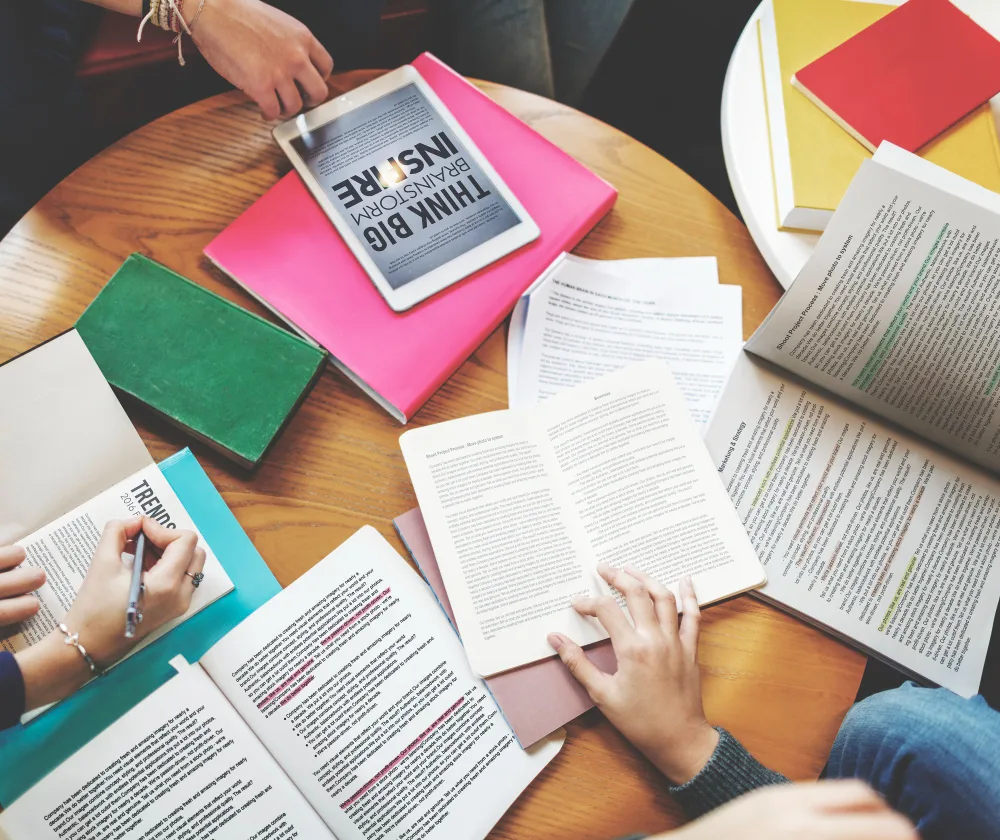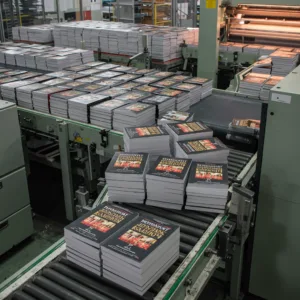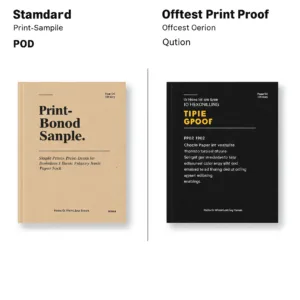Confused about the difference between printing and publishing your book? You’re not alone! This critical distinction can make or break your project’s success, impacting everything from costs to legal liabilities.
Printing focuses on the physical production of your book – the tangible process of turning your manuscript into a bound volume with paper, ink, and binding. Publishing, conversely, encompasses the entire business of bringing your book to market, including editing, design, marketing, distribution, and legal considerations. Think of printing as manufacturing the product, and publishing as managing the product’s lifecycle.
But that’s just the tip of the iceberg. We’ve uncovered seven crucial differences between printing and publishing that every author must know to avoid costly mistakes and legal pitfalls.
Defining the Core Difference: It’s More Than Just Ink on Paper
Let’s start with the fundamentals. It might seem obvious, but confusing these two is where many aspiring authors and businesses stumble.
Printing: The Manufacturing Process

Printing is all about the tangible. Think of the crisp feel of quality paper, the vibrant colors of a perfectly reproduced image, and the satisfying heft of a well-bound book. It involves choosing your paper stock (from lightweight uncoated paper to luxurious, heavy cardstock), selecting a binding method (perfect binding, saddle-stitch, case binding, spiral binding), deciding on ink types (CMYK for full-color, Pantone for spot colors), and adding finishing touches like gloss or matte lamination, embossing, or foil stamping.
As Orna Ross, author and founder of the Alliance of Independent Authors (ALLi) says, “Authors who self-publish are not just writers; they are publishers. They are responsible for every stage of the process, from writing and editing to printing and distribution.”
Publishing: The Business of Bringing Books to Market
Publishing, in contrast, is the business side of things. It encompasses everything before and after the physical printing. This includes acquiring or developing the content, editing and refining the manuscript, securing the necessary rights and permissions, designing the cover and interior layout, creating metadata (the information that helps people find your book online), managing distribution, and handling marketing and sales.
Analogy Time: Cooking vs. Running a Restaurant
Think of it this way: printing your manuscript is like a chef expertly preparing a delicious dish, using the finest ingredients and techniques. Publishing is like running a successful restaurant. You need a compelling menu (your book’s concept and content), an appealing ambiance (your book’s design and presentation), effective marketing (attracting customers to your restaurant), and efficient service (getting the book into readers’ hands). You can have the best-tasting dish in the world, but if nobody knows about it, or if it’s poorly presented, your restaurant (or book) won’t succeed.
The Process Breakdown: Who Does What (and When)?
Understanding the distinct workflows of printing and publishing is crucial for managing your project effectively and avoiding costly delays. Let’s break down each process step-by-step.
The Printing Workflow
The printing process, while seemingly straightforward, involves several critical stages:
- File Submission: You provide your finalized, print-ready files (usually a high-resolution PDF) to the printer.
- Prepress Checks: The printer’s prepress department examines your files for any technical issues, such as incorrect image resolution, missing fonts, or improper color settings. This is a crucial step to catch errors before they become expensive printing mistakes.
- Proofing: You receive a proof (either digital or physical) to review and approve. This is your last chance to catch any errors or make any final adjustments.
- Printing: Once you approve the proof, the actual printing begins, using the chosen printing method (offset, digital, etc.).
- Binding: The printed pages are assembled and bound together according to your chosen binding style.
- Quality Control: The printer inspects the finished product for any defects, ensuring it meets the agreed-upon standards.
- Shipping: The finished books are packaged and shipped to you or your distributor.
At Mainland Printing, we pride ourselves on a streamlined printing process with rigorous quality control at every stage. Our advanced prepress system automatically detects many common file errors, saving you time and money.
The Publishing Workflow
The publishing process is considerably more complex and involves a wider range of activities:
- Manuscript Acquisition/Writing: This is where the book’s content is created. In traditional publishing, a publisher might acquire a manuscript from an author. In self-publishing, the author is responsible for writing the book.
- Editing: This involves multiple rounds of editing, including developmental editing (focusing on structure and content), line editing (focusing on style and clarity), and copyediting (focusing on grammar and punctuation). It is important to hire professional editors.
- Cover Design: A professional cover is essential for attracting readers. Consider book cover design costs.
- Interior Layout (Typesetting): The interior of the book is formatted for readability and visual appeal. This includes careful attention to typography in book design.
- ISBN Acquisition: An ISBN (International Standard Book Number) is required for selling your book through most retail channels. In the US, you can obtain an ISBN through Bowker. A single ISBN costs $125, but you can buy in bulk for a better price.
- Metadata Creation: This includes the book’s title, author, description, keywords, and BISAC codes (subject categories). Accurate metadata is critical for online discoverability.
- Distribution Setup: You’ll need to decide how your book will be distributed (e.g., through Amazon KDP, IngramSpark, or direct sales).
- Marketing & Promotion: This is an ongoing process that includes building an author platform, engaging with readers, and running advertising campaigns.
Hybrid Models: The Blurring Lines
It is important to note that hybrid models also exist. Hybrid publishing allows you to be more selective, picking just the services you need. Perhaps you’ll handle the writing, but hire a freelance editor, a cover designer, and let a print-on-demand service handle the distribution.
The key takeaway here is that self-published authors must either handle all these publishing tasks themselves or outsource them to freelancers or service providers.
Legal Liabilities: Who’s Responsible for What?
Understanding the legal distinctions between printing and publishing is paramount to protecting yourself from potential lawsuits and financial losses. This is where many first-time authors and businesses make critical mistakes.
The Printer’s Limited Liability
Generally speaking, printers are not held responsible for the content of the materials they print. Their role is to accurately reproduce the files provided to them. Under Section 512 of the US Digital Millennium Copyright Act (DMCA), printers are often considered “mere conduits” of information and are shielded from liability for copyright infringement, unless they knowingly print illegal material.
Real-World Example: If you, as a self-published author, unknowingly use a copyrighted image in your book, the printer who prints your book is typically not liable for the infringement. The responsibility falls solely on you. However, the printer may cease printing if informed of the infringement.
The Publisher’s (or Self-Publisher’s) Full Responsibility
The publisher, whether it’s a traditional publishing house or a self-published author, bears the full legal responsibility for the book’s content. This includes:
- Copyright Infringement: Using copyrighted material (text, images, music) without permission, a concept further explained by Stanford University Libraries on copyright and fair use.
- Libel and Defamation: Publishing false and damaging statements about someone.
- Privacy Violations: Revealing private information about someone without their consent.
- Obscenity and Other Illegal Content: Publishing material that violates obscenity laws or other legal restrictions.
As Jane Friedman, a publishing industry expert with over 25 years of experience, puts it: “Publishing… is about acquiring, developing, and bringing a book to market – it’s a business.” And with any business, there comes responsabilities.
If you are self-publishing, you are the publisher, and you are legally responsible for ensuring that your book does not violate any laws or infringe on anyone’s rights. This is why obtaining an ISBN and registering your copyright are so important – they provide a level of legal protection and establish you as the official publisher of record.
ISBN is Mandatory
It is important to realize that in the US, you must obtain an ISBN if you intend to sell the book, to register in the system.
Cost Structures: Where Does Your Money Really Go?
Understanding the different cost structures of printing and publishing is essential for budgeting your project and making informed decisions. Let’s examine where your money actually goes in each scenario.
Printing Costs: The Tangible Expenses

Printing costs are relatively straightforward and are primarily determined by these factors:
- Paper Stock: The type of paper you choose (e.g., uncoated, glossy, matte, recycled) significantly impacts the cost. Heavier, higher-quality paper stocks are more expensive.
- Binding Type: Different binding methods (e.g., saddle-stitch, perfect binding, case binding) have different price points. Case binding (hardcover) is typically the most expensive.
- Print Run Size: The number of copies you print has a major impact on the per-unit cost. Larger print runs generally result in lower per-unit costs due to economies of scale.
- Color vs. Black & White: Printing in full color (CMYK) is significantly more expensive than printing in black and white.
- Finishing Options: Special finishes like embossing, foil stamping, or spot UV coating add to the cost.
- Page Count: More pages equals more paper and more ink.
A very simplified formula for estimating basic printing costs would be:
Cost = (Per-Unit Cost x Quantity) + Setup Fees
Keep in mind, that some areas, like California, have additional fees (5-10%) added to the final cost, due to regulations like AB 1200 regarding printing ink.
Publishing Costs: The Often-Hidden Expenses
Publishing costs are more variable and can include a wide range of expenses, many of which are often overlooked by first-time authors:
- Editing: Professional editing (developmental, line, and copyediting) is crucial for producing a high-quality book. Costs vary widely depending on the editor’s experience and the length and complexity of your manuscript.
- Cover Design: A professional cover design is essential for attracting readers.
- Interior Layout (Typesetting): Formatting the interior of your book for readability and visual appeal.
- ISBN Acquisition: As previously mentioned, an ISBN is required for selling your book through most retail channels.
- Marketing & Advertising: This can include everything from online advertising to book tours to public relations.
- Distribution Fees: If you use a distributor like IngramSpark, you’ll pay fees for their services.
- Returns: If you sell your book through traditional retail channels, you’ll need to account for the cost of returns (unsold books that are returned by retailers).
Self-Publishing vs. Traditional Publishing: A Cost Comparison

| Cost Type | Printing (Self-Publishing Component) | Publishing (Traditional) |
|---|---|---|
| Fixed Costs | Setup fees (if any), potentially design costs if DIYing | Editor salaries, ISBN, potentially author advance |
| Variable Costs | Per-unit printing cost, shipping | Royalties (typically 15-25% of net sales), marketing |
| Hidden Costs | Potential for reprints due to errors, storage | Marketing and promotion, returns |
Key Takeaway: In traditional publishing, the publisher covers the upfront costs, but the author receives a smaller percentage of the profits (royalties). In self-publishing, the author covers all the upfront costs, but they keep a larger percentage of the profits.
For example, self-publishing a 200-page paperback book in the US might cost around $8 per book for a print run of 500 copies, including the ISBN fee.
Technical Specifications: Avoiding Costly Mistakes
Navigating the technical requirements of printing and publishing can be daunting, but understanding the key specifications is crucial for avoiding costly errors and ensuring a professional-looking final product.
Printing Specs: The Printer’s Language

Printers have a specific language and set of requirements. Here are some of the most important terms you need to know:
- DPI (Dots Per Inch): This refers to the resolution of your images. For print, you generally need a resolution of at least 300 DPI for sharp, clear images. Lower resolutions will appear blurry or pixelated.
- CMYK vs. RGB: These are color models. CMYK (Cyan, Magenta, Yellow, Black) is the standard color model for printing. RGB (Red, Green, Blue) is the color model used for digital displays. You must convert your files to CMYK before sending them to a printer.
- Bleed: This is an extra area of your design that extends beyond the trim edge of the page. It ensures that your design goes all the way to the edge of the page after trimming. A standard bleed is usually 3mm.
- Trim Size: This is the final size of your printed page after it has been trimmed.
- Gutter: This is the inner margin of a book, where the pages are bound together.
- Spine Width: This is the width of the book’s spine, which depends on the number of pages and the thickness of the paper.
Visual Aid: A diagram showing bleed, trim, and safe areas would be immensely helpful here.
At Mainland Printing, we provide detailed file preparation guidelines and templates to help our clients avoid common mistakes. We understand that these technical details can be overwhelming, and we’re here to guide you through the process.
Publishing Specs: The Distribution Requirements
Publishing also has its own set of technical requirements, primarily related to metadata and file formats:
- ISBN: As discussed, the International Standard Book Number is essential.
- Barcode: This is a scannable representation of the ISBN, usually placed on the back cover of the book.
- Copyright Page: This page contains important information about the book, including the copyright notice, publisher information, and ISBN.
- Metadata: This includes the book’s title, author, description, keywords, and BISAC codes (subject categories). Accurate and comprehensive metadata is crucial for making your book discoverable online. You will want to do some research on what keywords your target audience will use.
- File Formats: Different platforms have different file format requirements. For example, Amazon KDP accepts MOBI and EPUB files for ebooks, and PDF files for print books. IngramSpark has its own set of specifications.
Common Mistakes and How to Avoid Them
Here are some of the most frequent mistakes that authors and businesses make:
- Low-Resolution Images: Using images that are too low in resolution for print.
- Incorrect Color Mode: Submitting files in RGB instead of CMYK.
- Missing Bleed: Not including a bleed area in the design.
- Font Issues: Not embedding fonts properly or using fonts that are not licensed for commercial use.
- Incorrect File Format: Sending a Word Document when a PDF is required.
- Incorrect Spine Size Calculations: If the spine is incorrectly calculated, the printing will be misaligned.
Pro Tip: Always double-check the specific requirements of your printer and your chosen distribution platform before you finalize your files.
Market Reach: Getting Your Book into Readers’ Hands
This section highlights a fundamental difference: printing gets your book made; publishing gets your book sold.
Printing and Distribution: Separate but Connected
It’s crucial to understand that printing and distribution are typically separate processes. A printer’s primary job is to manufacture your book. They usually don’t handle getting it into bookstores or online retailers, unless they offer specific print-on-demand (POD) services integrated with distribution.
Mainland Printing, for instance, focuses on the creation of high-quality books. We ensure your files are perfectly prepared for distribution, offering packaging and shipping services to get your books where they need to go, whether that’s directly to you, to a fulfillment center, or to a distributor. However, we don’t negotiate with retailers or manage sales.
Traditional Publishing Distribution
Traditional publishers have established distribution networks that include:
- Wholesalers: Companies like Ingram that supply books to bookstores, libraries, and other retailers.
- Retailers: Brick-and-mortar bookstores (like Barnes & Noble) and online retailers (like Amazon).
- Libraries: Public and academic libraries.
The advantage of traditional publishing is this extensive reach. However, the author has less control over pricing and marketing, and receives a smaller royalty percentage.
Self-Publishing Distribution Options

If you self-publish, you have several distribution options, each with its own pros and cons:
- Amazon KDP (Kindle Direct Publishing): This is the most popular platform for self-published authors.
- Pros: Huge reach (Amazon’s massive customer base), easy setup, print-on-demand (POD) service, higher royalties than traditional publishing (up to 70%).
- Cons: Limited to the Amazon ecosystem, less control over pricing and marketing compared to direct sales, no presence in physical bookstores (unless you also use a service like IngramSpark).
- IngramSpark: This platform provides access to a wider distribution network, including bookstores, libraries, and online retailers beyond Amazon.
- Pros: Broader reach than KDP, ability to get your book into physical bookstores.
- Cons: Higher setup fees than KDP, more complex interface, requires more technical knowledge.
- Direct Sales: Selling your book directly to readers through your own website or at events.
- Pros: Highest profit margin, direct relationship with your customers, complete control over pricing and marketing.
- Cons: Requires more effort to reach a wide audience, you handle all fulfillment and customer service.
- Other options: You also have the option of using platforms like Draft2Digital or Smashwords.
Important Note: Even if you purchase your own ISBN, if you don’t have a distribution agreement with a major wholesaler or distributor, most large bookstore chains in the US (like Barnes & Noble) will likely not stock your book on their shelves. They primarily work with established publishers and distributors.
Long-Term Value: Building a Sustainable Author Career

The final key difference between printing and publishing lies in their impact on your long-term goals. Are you simply looking to create a physical product, or are you aiming to build a sustainable career as an author or establish a brand?
Printing as a One-Time Transaction vs. Publishing as a Long-Term Strategy
Think of printing as a service – you pay for a specific product (printed books). It’s a transactional relationship. Publishing, on the other hand, is about building a business and a relationship with your readers.
Building an Author Platform
Whether you choose traditional publishing or self-publishing, building an author platform is crucial for long-term success. This means:
- Creating a website: Your online home base, where readers can learn more about you and your books.
- Building an email list: A direct way to communicate with your readers and promote your work.
- Engaging on social media: Connecting with readers and building a community around your books.
- Developing a consistent brand: Creating a recognizable identity as an author.
These are all aspects that fall under publishing.
Hybrid Approaches: The Best of Both Worlds
It is also possible to combine aspects of the two. Example: Launch with POD to test the market, and later find a traditional publishing deal. Example: Self-publish niche books, while using traditional publishing with books that can appeal to a larger public.
This is especially important for self-published authors, who don’t have the marketing and publicity resources of a traditional publisher. Your platform is your direct line to your audience, and it’s essential for driving sales and building a loyal readership.
Conclusion
Printing and publishing are distinct, yet interconnected, processes. Printing is the manufacturing of your book; publishing is the business of getting it into the hands of readers and building a sustainable career.
Understanding this crucial difference is the first step towards making informed decisions, avoiding costly mistakes, and achieving your publishing goals. Consider printing the creation of the product, and publishing the creation of value for that product.
Ready to get your project started? Contact Mainland Printing today for a free quote. We can help you navigate every stage of the printing. We’re committed to providing high-quality printing at competitive prices, with exceptional customer service every step of the way.







